There’s a new tick in town and it spells bad news for New York State residents who like the outdoors.
Borriella miyamotoi, B. miyamotoi for short– yes it sounds like a Ninja Warrior—has turned up here in the United States for the first time this year and New Yorkers are among those most at risk—New York is one of 13 states in which 96% of instances of Lyme disease occur, verifying a large and apparently growing tick population..
Experts are concerned the new bacteria may go unnoticed because there is no test for it yet and it mimics some of the other infections already raging through states with tick issues. It is possible to miss the infection, they say, if physicians test for Lyme disease and the test is negative they may not continue looking in the right direction.
B. miyamotoi, a pathogen carried by blacklegged ticks, is closely associated with the fever pattern in some Lyme disease-like illnesses. Fevers can spike and drop at random. The bacteria were first identified in humans in 2011 during a study conducted among a group of Russian patients. Their fevers would go away and then come back days, or even weeks later.
Other symptoms of the new infection are also like those found in Lyme disease. Patients have complained of fever, headache, nausea and muscle pain and basically all the signs we identify with the common flu.
Experts have released information that the new bacteria responds to antibiotic therapy used to treat similar infections successfully. Both doxycycline and amoxicillin are readily available and have proven to offer effective antibiotic therapy to alleviate symptoms and stop the infection. If however there is no treatment, fevers are expected to repeatedly return and other symptoms, including mental confusion may present.
In addition to the illness that could be caused by the new bacteria, there remains a multitude of other infections caused by tick bites in and around our region. Because of the increased exposure to ticks during the summer months while engaging in outdoor activity, it is strongly recommended that you follow tips for preventing ticks from attaching themselves to you, a loved one or your pets and to be prepared to remove them in the event there is an attachment.
TICKS CAN MAKE YOU SICK…
Just remember that if you’re living in or visiting a place or participating in activities outside where ticks could be present, you need to know how to keep them off you and also to get them off you, or anyone else they manage to land on—and yes that includes your beloved pets who are totally defenseless against these pests.
 These bugs mean business. They need blood—ours or our pets—to survive. Female ticks can only produce eggs if they get blood and once they hook up on their host they can consume up to 400 times their own body weight, in your blood, to feed their needs.
These bugs mean business. They need blood—ours or our pets—to survive. Female ticks can only produce eggs if they get blood and once they hook up on their host they can consume up to 400 times their own body weight, in your blood, to feed their needs.
Ticks are very small and can hide. It is imperative that you take every precaution in keeping them off you in the first place and to wear clothing that either prevents or discourages their attachment.
You should spray all exposed areas with tick repellent, either commercially available or self-prepared, as a preventative measure.
In the event that you discover a tick that has to be removed, you should be prepared to take it out and dispose of it properly.
NEVER FLUSH A TICK!
THEY WILL INVARIABLY FIND THEIR WAY OUT OF THE WATER!
Perform a thorough check if you think you’ve been around ticks—likely you won’t know they are on your skin until after they have done their damage. Their saliva is made up of different compounds, one of which acts as a “skin anesthetic” while another thins out you blood so it flows fast and free without your knowledge. Charming little critters right?
In any and all cases when you find them they have to go!
HOW TO REMOVE A TICK
1. Find the head of the tick. In most cases, it will be buried just beneath the skin.
2. Pour hydrogen peroxide over the area.
3. You’ll need to take it out with tweezers. Tweezers give you plenty of pull to get the tick out, and odds are you have a pair lying around the house.Get a pair of fine-pointed tweezers. The smaller and tighter the grip, the better.
4. Grip the tick’s head. Get the tweezers as close to the mouth of the tick as possible. Do not grasp the tick’s body. This will cause it to inject saliva or blood into your skin and increase the chances of transmitting a disease
5. Pull firmly and steadily outward. Do not twist, jerk or wiggle the tweezers as you pull. It’s not uncommon for your skin to also pull up as the tick detaches, much like it does when you pluck a stray hair.
6. Save the tick in a plastic bag (optional). If you suspect you have a tick-borne illness, you can take it in for testing.
7. Make sure that the tick has been entirely removed. If the head of the tick is still in your skin — and you’ll be able to see it, don’t worry — go see a doctor.
8. Treat the wound with antiseptic. Alcohol can be used to help prevent the spreading of tick-borne disease. This is most effective right after the tick is removed.
DO NOT:
• Try to smother a tick by covering it with petroleum jelly or Vaseline
• Try to burn it out with or freeze them out
• Try to drown it with nail polish remover
None of these methods work and can because damage to the host.
Recipes to repel/prevent tick bites by spraying repellent on your pets and people who could be exposed.
REPELLENT FOR PETS
• For pets, add 1 cup of water to a spray bottle, followed by 2 cups of distilled white vinegar. Ticks hate the smell and taste of vinegar, and will be easily be repelled by this ingredient alone. Then, add two spoonfuls of vegetable or almond oil, which both contain sulfur (another natural tick repellent). To make a repellent that will also deter fleas, mix in a few spoonfuls of lemon juice, citrus oil, or peppermint oil, which will all repel ticks and fleas while also creating a scented repellent.
Spray onto the pet’s dry coat, staying away from sensitive areas including eyes, nose, mouth, and genitals. When outdoors for an extended period, spray this solution on two to three times per day. When pets are outdoors generally to use the restroom only, spray the solution onto the animal’s coat once per day.
REPELLENT FOR HUMANS
• A simple homemade repellent can be made with a few inexpensive household ingredients. In a spray bottle, mix 2 cups of distilled white vinegar and 1 cup of water. To make a scented solution so you do not smell like bitter vinegar all day, add 20 drops of your favorite essential oil or bath oil. Eucalyptus oil is a calm, soothing scent that also works as a tick repellent, while peppermint and citrus oils give off a strong crisp scent that also repel ticks.
After mixing the solution, spray onto clothing, skin, and hair before going outdoors. Reapply every four hours to keep ticks at bay, and examine the skin and hair when returning home to make sure no ticks are on the body.


